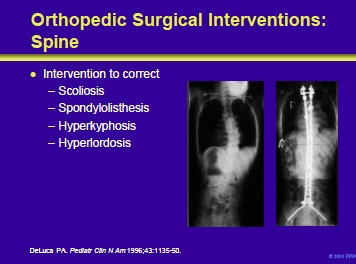Article Index
Page 5 of 19

Scoliosis, spondylolisthesis, hyperkyphosis and/or hyperlordosis in patients with cerebral palsy create difficulties in maintaining a seated position and, in patients with severe forms, can produce obliquity of the pelvis, ischial pressure sores and cardiopulmonary compromise. Management of scoliosis by bracing is less successful in halting progression in patients with cerebral palsy than in idiopathic forms.
However, bracing can be used to delay the need for surgery in the very young. When curves progress to >40 degrees and lose their flexibility, some form of segmental instrumentation is indicated (as shown in this slide).
DeLuca PA. The musculoskeletal management of children with cerebral palsy. Pediatr Clin N Am 1996;43:1135-50.
